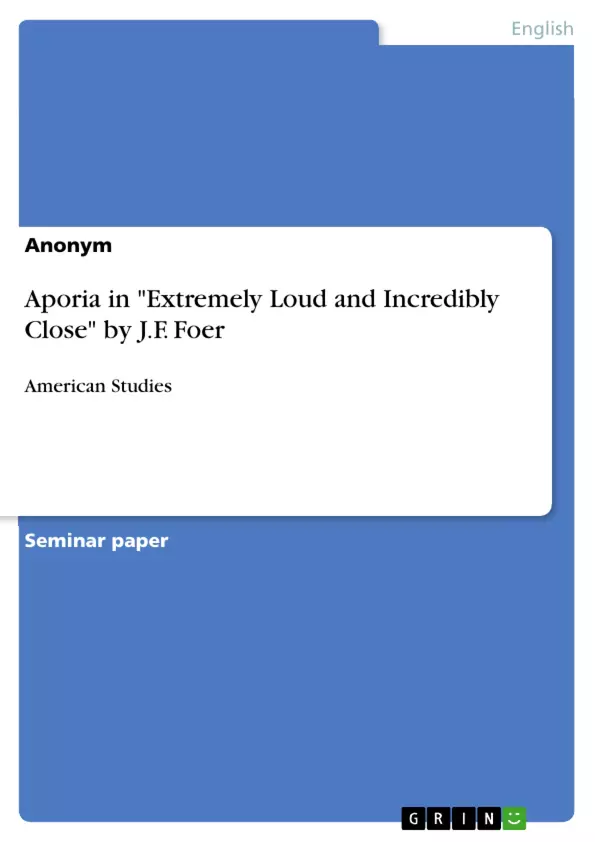After a traumatizing event it is psychologically well-known that adequate words are hard to find in order to express emotions and fears. As an example, 9/11 was not only a worldchanging tragedy; it also influenced and radically changed the personal lives of many, having to cope with loss and trauma. Looking at post- 9/11 fictional novels, Jonathan Safran Foer’s Extremely Loud and Incredibly Close is a story about nine-year old Oskar who has lost his father in the World Trade Center on the day of the attacks. It describes his journey through New York City, trying to find a lock belonging to a key he found of his deceased father.
Interpreting the novel as a trauma narrative, the story evokes themes of loss and coping, not only of Oskar but also of his mother and grandparents. Because mourning oftentimes leads to aporia, Jonathan Safran Foer employs a wide range of stylistic heterogeneity, representing the unspeakable in numerous ways throughout the novel. As a form of adaptation, the novel has experienced a transformation into a movie. Subsequently it is questionable in how far the unspeakable is conveyed within the movie and which strategies are therefore employed.
In this essay, adaptation theory will be shortly analyzed as means of familiarization with different media. Following this, the representation of the unspeakable will be regarded in its depiction within the novel in order to compare in how far aporia can be overcome within the movie. Finally, major differences and similarities will be revised in order to process the value of the different genres.
Inhaltsverzeichnis (Table of Contents)
- Introduction
- Adaptation Theory
- Aporia- Representing the Unspeakable
- Representation of Aporia in the Novel
- Representation of Aporia in the Movie
- Conclusion
Zielsetzung und Themenschwerpunkte (Objectives and Key Themes)
This essay analyzes the representation of aporia in Jonathan Safran Foer's novel Extremely Loud and Incredibly Close and its film adaptation. The essay aims to examine how the unspeakable is conveyed in both mediums, focusing on the novel's use of stylistic heterogeneity and the film's adaptation strategies. By comparing the two, the essay seeks to understand the unique value of each genre in representing trauma narratives and how they contribute to the audience's understanding of the themes of loss and coping.
- Representation of trauma narratives
- Aporia and the unspeakable
- Adaptation theory and intermediality
- Stylistic heterogeneity in literature and film
- The value of different genres in conveying emotions
Zusammenfassung der Kapitel (Chapter Summaries)
The essay begins by introducing the concept of aporia, particularly as it relates to the aftermath of a traumatic event like 9/11. It then delves into the novel Extremely Loud and Incredibly Close, exploring how Foer utilizes stylistic heterogeneity to represent the unspeakable. The essay discusses how the novel's narrative techniques, such as Oskar's fragmented thoughts and sensory experiences, contribute to the overall representation of aporia.
The essay then shifts its focus to adaptation theory, outlining the different perspectives on adaptations and their relationship to the original text. It examines the significance of filmic adaptations in enriching the meaning of the original and how the medium of film can present a different approach to conveying emotions and meaning. The essay further explores the economic and social implications of adaptations.
Finally, the essay delves into the film adaptation of Extremely Loud and Incredibly Close, examining how the director and screenwriter have translated the novel's aporia into a visual and auditory experience. It analyzes the film's strategies in representing Oskar's emotions and the overall impact of the adaptation on the audience's understanding of the novel's themes.
Schlüsselwörter (Keywords)
The main keywords and focus topics of this essay include: trauma narratives, aporia, stylistic heterogeneity, adaptation theory, filmic adaptations, intermediality, 9/11, Extremely Loud and Incredibly Close, Jonathan Safran Foer, literary representation, film representation, emotions, loss, coping, and cultural capital.
- Arbeit zitieren
- Anonym (Autor:in), 2016, Aporia in "Extremely Loud and Incredibly Close" by J.F. Foer, München, GRIN Verlag, https://www.grin.com/document/538778



